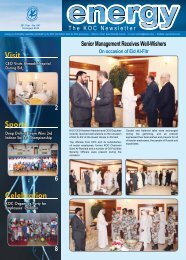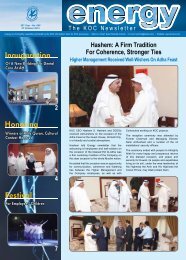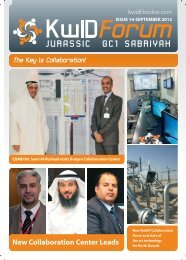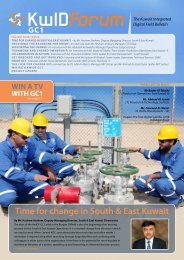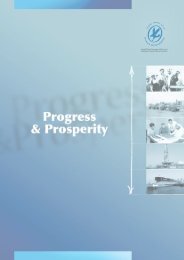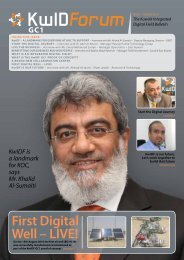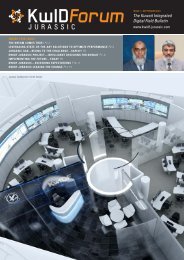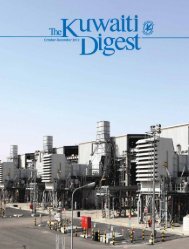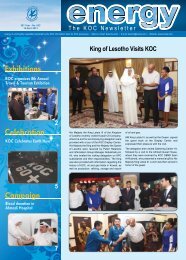6 - Kuwait Oil Company
6 - Kuwait Oil Company
6 - Kuwait Oil Company
Create successful ePaper yourself
Turn your PDF publications into a flip-book with our unique Google optimized e-Paper software.
the application window and should be used carefully<br />
by trained Engineer. The expert system does not<br />
replace the expert but does aid the engineer in the<br />
decision and speed up the selection process and<br />
minimize the dependence on A/L consultants.<br />
Figure 1. Table of A/L Typical Applications<br />
ALES Concept and Development<br />
An Expert System is a software that uses a knowledge<br />
base of human expertise for problem solving, or to<br />
clarify uncertainties where normally one or more human<br />
experts would need to be consulted [Wikipedia]. The<br />
main challenges that comes up from this concept are<br />
basically how the knowledge of the experts will be<br />
coded, how the system will use this human expertise<br />
database to talk and advise about an specific case and<br />
what inputs and calculations will feed the expert system.<br />
It was decided that the Expert System must be fed<br />
with real well parameters and outputs from internal<br />
calculations as if the design of each Artificial Lift<br />
Method is performed at the same time, regardless of<br />
the capability of a specific method to operate under the<br />
given well conditions. By this way, all limitations, critical<br />
conditions and variables that affect the performance<br />
will be calculated and sent to the expert module.<br />
Usually, most of the required parameters to design and<br />
select an A/L System are available. The first thing an<br />
expert would do with this information is to asses and<br />
questioning each A/L system performing under the<br />
given conditions. As an example, the expert may ask<br />
him/herself: Can a SRP produce 10000 BPD at 10000<br />
feet An Engineer with some expertise in this method<br />
may know that it will be difficult, thus he or she might<br />
start thinking about finding a different solution for this<br />
specific well. This approach reflects that there is a<br />
pre-assessment made by the expert based on his/her<br />
experience only, without executing any calculation and<br />
this is meant to be one of the first functionalities of ALES.<br />
Considering the same case mentioned in the above<br />
paragraph, this Engineer may consider an ESP System<br />
as a good option, however, at this stage there are other<br />
parameters that affects the ESP performance that need<br />
to be calculated such as the fraction of free gas into<br />
pump for the desired production rate. If this value is<br />
two high, the expert may start thinking about a different<br />
solution like Gas Lift for example. In this sense, it is<br />
evident that some design calculations must be executed<br />
to have a better picture of each A/L system performance.<br />
Assuming that the free gas into pump is acceptable<br />
and theoretically an ESP can do this Job for the above<br />
case, still it is necessary to calculate all stresses, torques<br />
and pressures under which this pump will operate<br />
and determine if a pump capable to operate under<br />
these conditions is manufactured and available in<br />
the market. After doing all of this for each Artificial<br />
Lift System, the Engineer will be totally capable to<br />
make the right and most assertive decision.<br />
Typically, to execute all the analysis mentioned<br />
before may take long time and might require<br />
more than one expert, thus ALES had to be<br />
designed to function in such a way that evaluating<br />
one case should take less than 5 minutes.<br />
In ALES, when a parameter is being evaluated, there are<br />
a quantitative complex rules whose output values goes<br />
from -1 (bad ) to +1 (excellent) . Figure 2 shows and<br />
example for production rates evaluation when using an<br />
ESP (at 50 hertz) for two different casings sizes (Red line<br />
the 5 ½” casing and green line 7”casing). As can be<br />
appreciated for rates below 500 BPD the corresponding<br />
rule in ALES gives a negative value because a typical<br />
ESP is going to operate below the recommended range<br />
(down-thrust) which reduces the run life, besides it is<br />
expected to have low ESP efficiencies for small pumps<br />
and the corresponding shafts are fragile. Then for rates<br />
from 500 to 1300 BPD the value is positive but lower<br />
than +1 because the pumps are close to the minimum<br />
(downthrust limit) recommended rate. For rates up to<br />
3200 BPD for both casings is the same and then the rule<br />
decreases for 5 ½’’ casing because it is reaching 5000<br />
BPD the maximum recommended limit (upthrust) until<br />
the maximum feasible limit of 5400 BPD. An equivalent<br />
situation happen for 7” casing but with higher rates<br />
because the pump capacities are higher for bigger<br />
pumps that fit inside 7” casing but they don’t in a 5 ½<br />
“casing. To explain this rule a target rate of 4500 BPD<br />
is assumed. In this sense, if the well has a 5 ½ casing<br />
the evaluation will be +0.7 (good but not excellent) and<br />
for a 7” casing the evaluation will be +1 (excellent).<br />
Figure 2. ALES Rules Example<br />
April - June 2013 33



